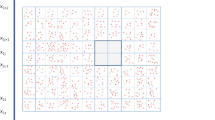Abstract
The fuzzy rule-based classifier can be taken as a function that assigns to a point from the feature space a class, or a class with an association degree. Under this assumption, the robustness of fuzzy rule-based classifiers is investigated by means of the Lipschitz condition. The Lipschitz continuity of fuzzy sets, fuzzy rules and whole fuzzy rule-based classifiers is examined for multi-polar outputs, extended multi-polar outputs and outputs in the form of a class. Related performance of a fuzzy rule-based classifier is also discussed. All studied concepts are shown on an exemplar fuzzy rule-based classifier.

Similar content being viewed by others
References
Anderson E (1935) The irises of the Gaspe Peninsula. Bull Am Iris Soc 59:2–5
Beliakov G, Calvo T, James S (2010) On Lipschitz properties of generated aggregation functions. Fuzzy Sets Syst 161(10):1437–1447
Calvo T, Mesiar R (2001) Stability of aggregation operators. In: Proceedings of second conference European Society for fuzzy logic and technology. Leicester, pp 475–478
Carmona P, Castro JL, Zurita JM (2004) Fuzzy rule identification with exceptions. IEEE Trans Fuzzy Syst 12(1):140–151
Casillas J, Cordón O, Del Jesus MJ, Herrera F (2001) Genetic feature selection in a fuzzy rule-based classification system learning process for high-dimensional problems. Inf Sci 136(1–4):135–157
Castro JL, Castro-Schez JJ, Zurita JM (1999) Learning maximal structure rules in fuzzy logic for knowledge acquisition in expert systems. Fuzzy Sets Syst 101(3):331–342
Cordón O, del Jesus MJ, Herrera F (1998) Genetic learning of fuzzy rule-based classification systems cooperating with fuzzy reasoning methods. Int J Intell Syst 13(1011):1025–1053
Cordón O, Del Jesus MJ, Herrera F (1999) A proposal on reasoning methods in fuzzy rule-based classification systems. Int J Approx Reason 20(1):21–45
De Cock M, Cornelis C, Kerre EE (2005) Elicitation of fuzzy association rules from positive and negative examples. Fuzzy Sets Syst 149(1):73–85
Fisher RA (1936) The use of multiple measurements in taxonomic problems. Ann Eugen 7(Part II):179–188
Grabisch M, Marichal J-L, Mesiar R, Pap E (2009) Aggregation functions. Cambridge University Press, Cambridge
Hastie T, Tibshirani R, Friedman J (2009) The elements of statistical learning, 2nd edn. Springer, Berlin
Hu YC, Tzeng GH (2003) Elicitation of classification rules by fuzzy data mining. Eng Appl Artif Intell 16(7–8):709–716
Ishibuchi H, Nozaki K, Tanaka H (1992) Distributed representation of fuzzy rules and its application to pattern classification. Fuzzy Sets Syst 52(1):21–32
Ishibuchi H, Nozaki K, Yamamoto N, Tanaka H (1994) Construction of fuzzy classification systems with rectangular fuzzy rules using genetic algorithms. Fuzzy Sets Syst 65:237–253
Ishibuchi H, Nakashima T, Murata T (2001) Three-objective genetics-based machine learning for linguistic rule extraction. Inf Sci 136(1–4):109–133
Ishibuchi H, Morisawa T, Nakashima T (1996) Voting schemes for fuzzy-rule-based classification systems. In: Proceedings of the Fifth IEEE international conference on fuzzy systems (FUZZ-IEEE’96), pp 614–620
Ishibuchi H, Yamamoto T (2005) Rule weight specification in fuzzy rule-based classification systems. IEEE Trans Fuzzy Syst 13(4):428–435
Isibuchi H, Yamamoto T, Nakashima T (2005) Hybridization of fuzzy GBML approaches for pattern classification problems. IEEE Trans Syst Man Cybern Part B Cybern 35(2):359–365
Kuncheva LI (2000) How good are fuzzy If-Then classifiers? IEEE Trans Syst Man Cybern Part B Cybern 30(4):501–509
Lee K-M (2004) Comparison of interval-valued fuzzy sets, intuitionistic fuzzy sets and bipolar-valued fuzzy sets. J Fuzzy Log Intell Syst 14(2):125–129
López V, Fernández A, del Jesus MJ, Herrera F (2013) A hierarchical genetic fuzzy system based on genetic programming for addressing classification with highly imbalanced and borderline data-sets. Knowl Base Syst 38:85–104
Mesiarová-Zemánková A (2014) Multi-polar aggregation operators in reasoning methods for fuzzy rule-based classification systems. IEEE Trans Fuzzy Syst 22(6):1569–1584
Mesiarová-Zemánková A, Ahmad K (2012) Multi-polar aggregation. In: Greco S et al (ed) Proceedings of IPMU’2012. Catania, pp 379–387
Mesiarová-Zemánková A, Ahmad K (2013) Multi-polar Choquet integral. Fuzzy Sets Syst 220:1–20
Mesiarová-Zemánková A, Ahmad K (2014) Extended multi-polarity and multi-polar-valued fuzzy sets. Fuzzy Sets Syst 234:61–78
Mesiarová-Zemánková A, Hyčko M (2014) Multi-capacities and multi-polar capacities. Fuzzy Sets Syst. doi:10.1016/j.fss.2014.12.005
Mitra S, Kuncheva LI (1995) Improving classification performance using fuzzy MLP and two-level selective partitioning of the feature space. Fuzzy Sets Syst 70(1):1–13
Nauck D, Kruse R (1997) A neuro-fuzzy method to learn fuzzy classification rules from data. Fuzzy Sets Syst 89(3):277–288
Pitambare DP, Kamde PM (2013) Fuzzy classification system for glass data classification. Int J Eng Res 2(2):33–37
Roubos JA, Setnes M, Abonyi J (2003) Learning fuzzy classification rules from labeled data. Inf Sci 150(1–2):77–93
Sánchez L, Couso I, Corrales JA, Cordón O, Del Jesus MJ, Herrera F (2001) Combining GP operators with SA search to evolve fuzzy rule based classifiers. Inf Sci 136(1–4):175–191
Acknowledgments
I would like to thank the editor and two anonymous reviewers for their valuable comments. This work was supported by grants VEGA 2/0049/14, APVV-0073-10 and Program Fellowship of SAS.
Author information
Authors and Affiliations
Corresponding author
Additional information
Communicated by M. Navara.
Rights and permissions
About this article
Cite this article
Mesiarová-Zemánková, A. Sensitivity analysis of fuzzy rule-based classification systems by means of the Lipschitz condition. Soft Comput 20, 103–113 (2016). https://doi.org/10.1007/s00500-015-1744-z
Published:
Issue Date:
DOI: https://doi.org/10.1007/s00500-015-1744-z




